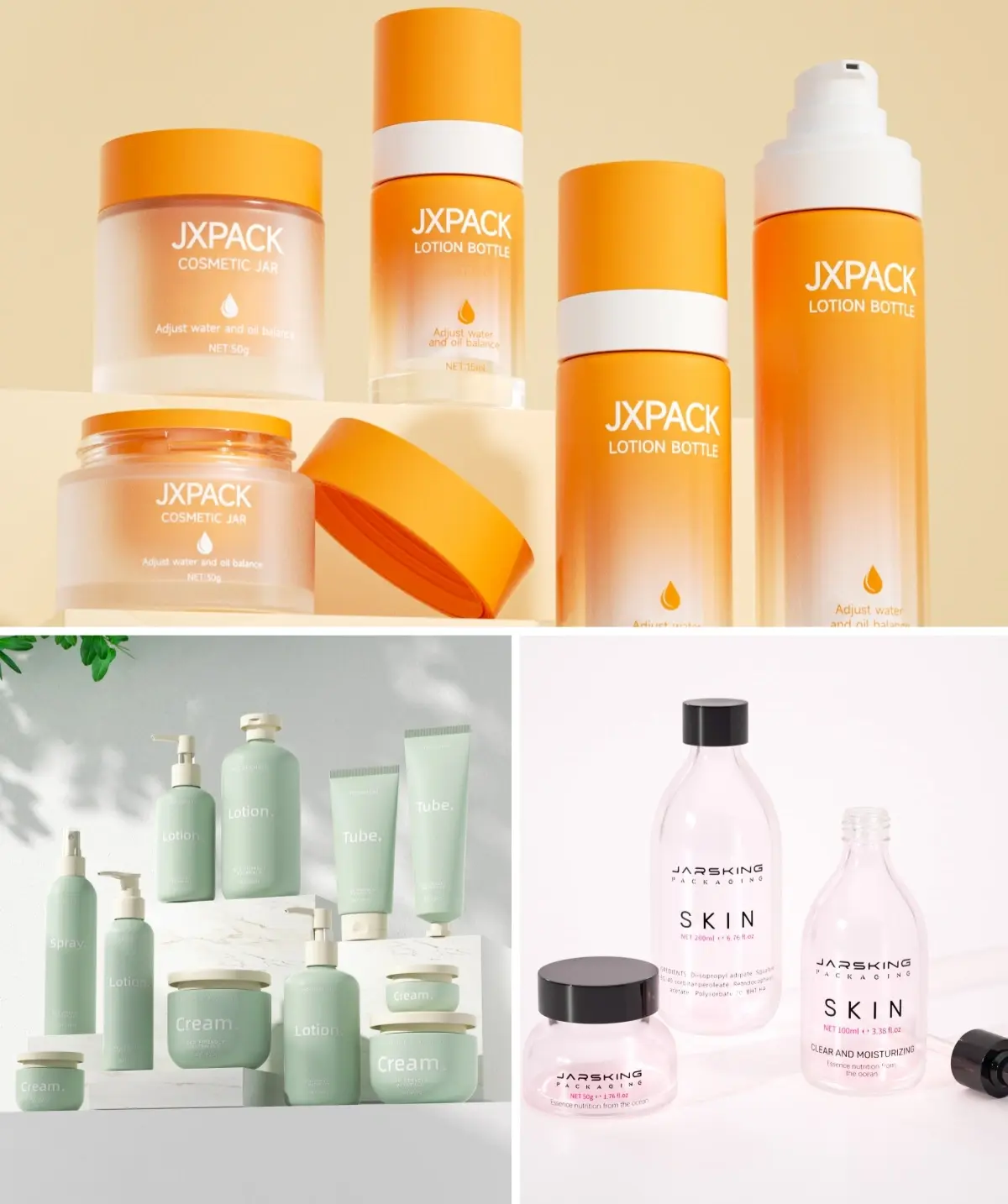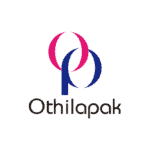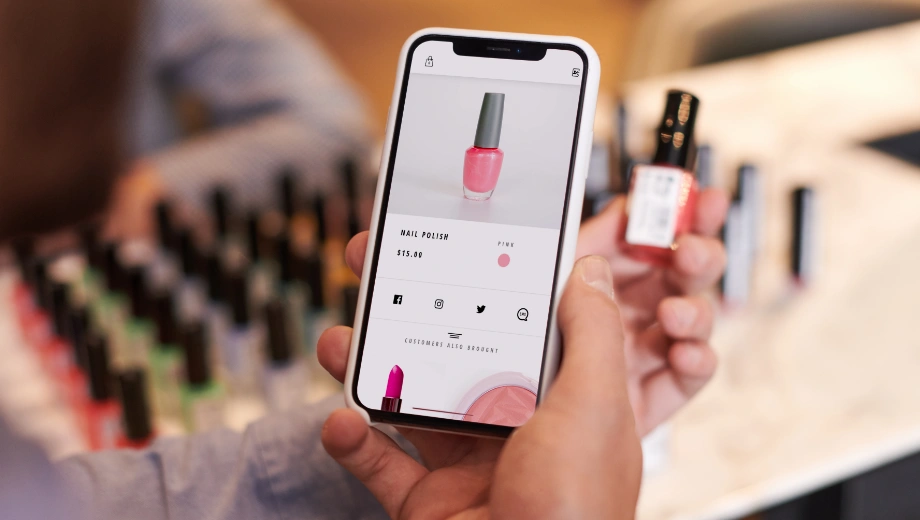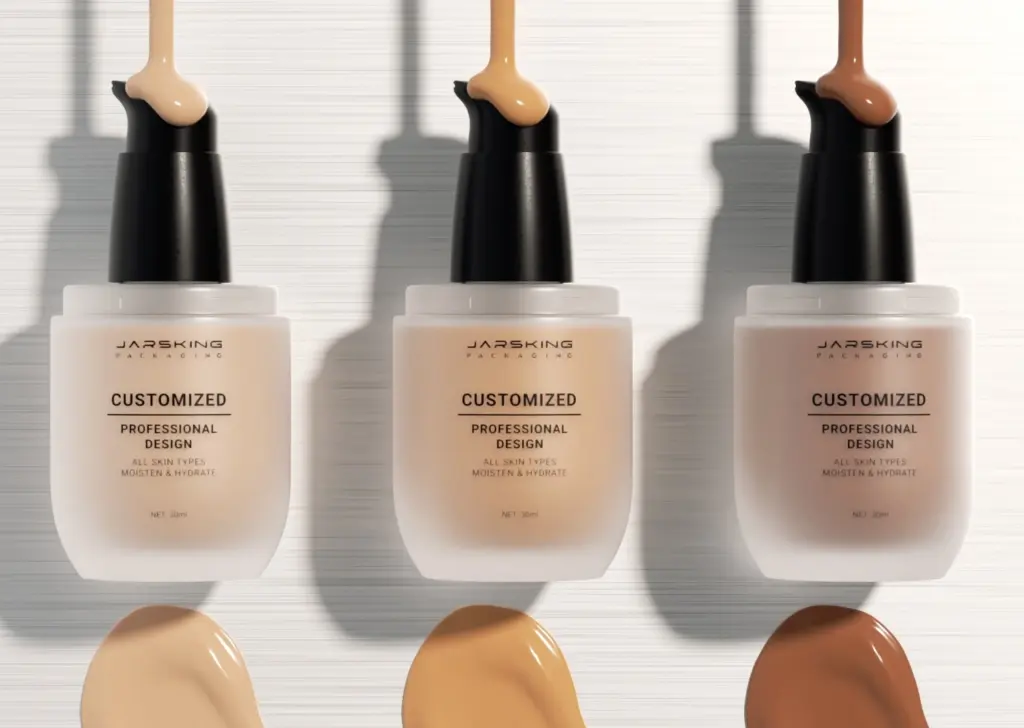In the world of skincare, packaging is more than just a container; it is a statement of brand identity, consumer experience, and sustainability efforts. Three brands that masterfully blend these elements are Tatcha, Aesop, and REN Clean Skincare. Each of these brands has set new standards in luxury, minimalism, and eco-conscious innovation, redefining how packaging enhances the skincare experience.
From delicate glass jars with gold detailing to minimalist apothecary-style bottles and zero-waste innovations, these brands demonstrate how sustainability can coexist with beauty. This article explores how Tatcha, Aesop, and REN Clean Skincare are leading the charge in sustainable packaging while maintaining their distinct brand identities.
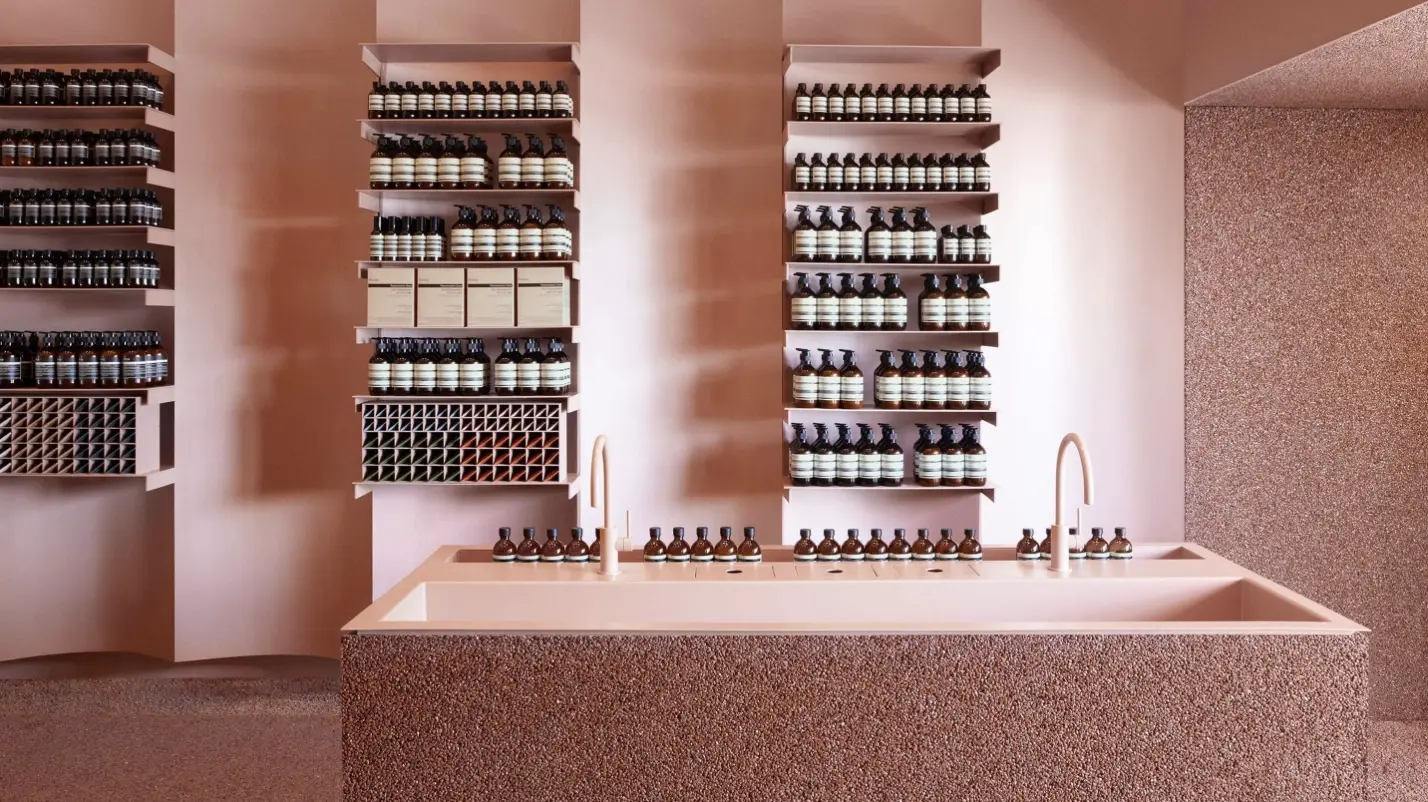
Tatcha: The Art of Japanese-Inspired Luxury Packaging
Tatcha’ s packaging is a masterclass in blending Japanese cultural heritage with avant-garde sustainability, creating a tactile and visual narrative that elevates skincare to an art form. Each element—from material choices to ergonomic design—serves as a bridge between ancient rituals and modern environmental responsibility.
Cultural Philosophy & Design Inspiration
Roots in Geisha Traditions
• Natsume Jars: Inspired by natsume tea caddies used in Japanese tea ceremonies, Tatcha’s moisturizer jars feature weighted, ergonomic designs that nestle perfectly in the palm. Paired with gold spoons for hygienic application, these jars evoke the precision of geisha beauty rituals.
• Color Symbolism:
– Kyoto Purple: The signature hue mirrors the dusk skies of Kyoto and the prestige of geisha culture, symbolizing luxury in Japanese tradition.
– Pearlescent White: Reflects the iconic makeup of geisha, achieved through crushed pearl formulations, while the packaging’ s iridescent finish mimics the luminosity of their complexion.
Artisanal Motifs
• Hexagonal Patterns: Adorning early packaging for blotting papers, these designs draw from tortoise motifs (kikko), symbolizing longevity in Asian culture.
• Kanji & Gold Leaf: Delicate kanji characters and 23k gold flecks in Original Aburatorigami papers pay homage to Kyoto’s gold-leaf artisans, who first repurposed abaca paper for skincare.
Collaborative Design Evolution
• Tether, Tatcha’s design partner, translated the brand’ s “ancient meets modern” ethos into packaging that juxtaposes geisha illustrations with minimalist typography. The inaugural aburatorigami papers arrived in soy-ink-printed, recyclable envelopes featuring geisha artwork—a design that set the tone for future collections.
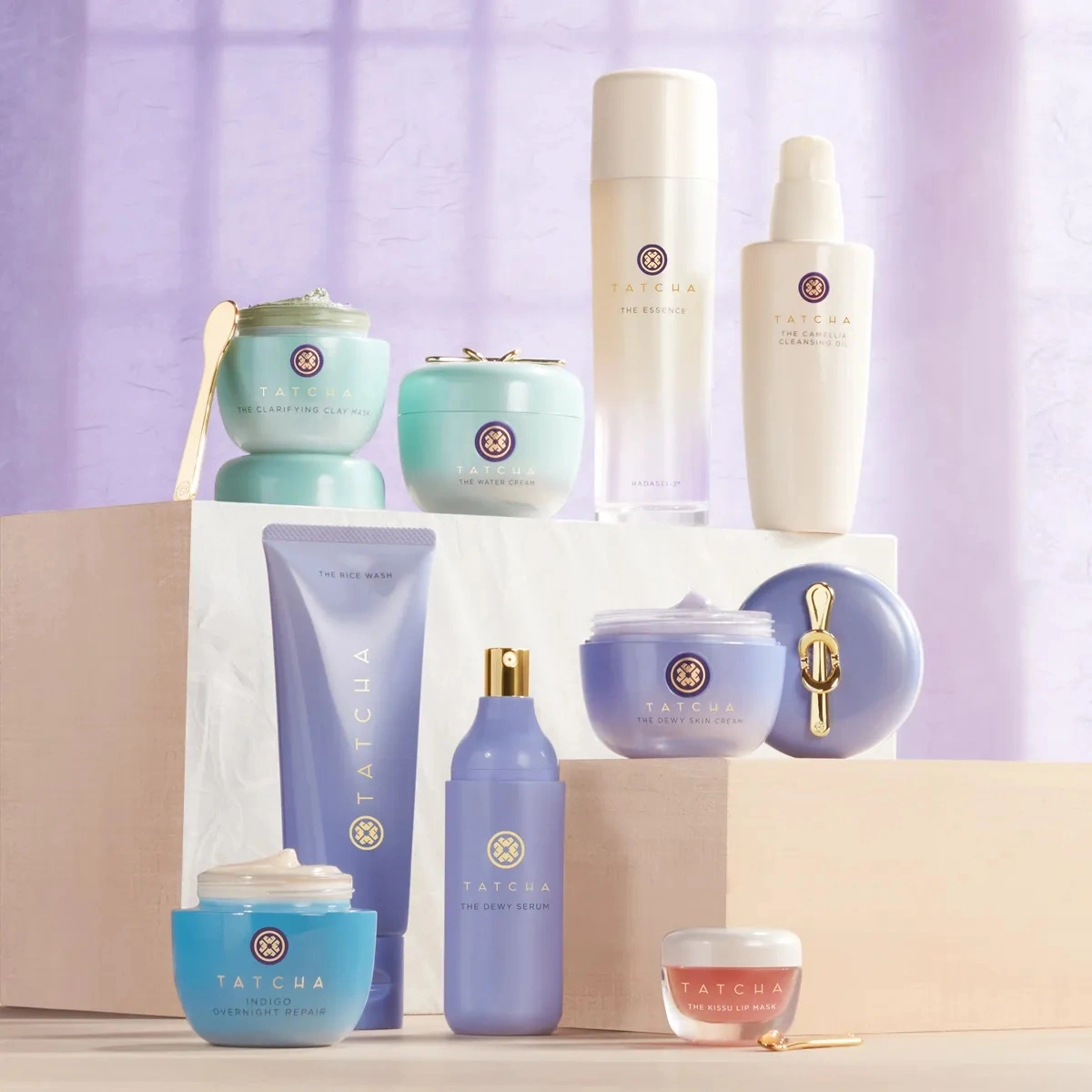
Material Innovation & Sustainability
Circular Refill Systems
• Refill Pods: Bestsellers like The Water Cream and Dewy Skin Cream now feature refillable pods, reducing plastic use by 57% per refill and offering a 14% cost savings. One refill slashes plastic consumption by 74%, aligning with the mottainai (“too precious to waste”) philosophy.
• Shower-Friendly Redesigns: The Deep Cleanse exfoliator’s new tube uses 22% less plastic, while The Rice Polish jar integrates a push-to-open spout to prevent water ingress and clogs.
Eco-Conscious Material Shifts
• Post-Consumer Recycled (PCR) Plastic: The Rice Polish jar and cap combine 30% PCR plastic with mono-material polypropylene for easier recycling.
• Glass Transition: The Essence now uses glass bottles, improving recyclability and reducing contamination risks compared to plastic.
• FSC-Certified Paper: All paper packaging supports responsible forestry, with soy-based inks minimizing environmental impact.
Carbon Neutrality & Accountability
• Truck-Stop Electrification: Tatcha offsets 100% of transportation emissions by funding projects that eliminate diesel idling, benefiting drivers and reducing CO2 by ~1 gallon/hour.
• APR Testing: Packaging undergoes rigorous recyclability checks, including Near Infrared Sorting and Extrusion Tests, to ensure compatibility with recycling systems.
Unboxing Experience: Sensory Storytelling
Personalized Rituals
• Orders arrive in FSC-certified boxes lined with purple tissue—a nod to Kyoto’s prestige—and include handwritten notes, samples, and inserts detailing product origins (e.g., Hadasei-3™ complex derived from 200-year-old geisha rituals).
• Dynamic Inserts: Tailored content explains ingredient traceability (e.g., Uji green tea, Okinawa algae) and application techniques, bridging education and luxury.
Ergonomic Design
• Silk-Textured Finishes: Jars and bottles feature tactile surfaces that mirror the smoothness of Tatcha’s formulas, enhancing the sensory experience.
• Weighted Jars: Inspired by natsume tea caddies, their heft conveys indulgence while ensuring stability during use.
Future Goals & Industry Impact
2025 Sustainability Roadmap
• 100% Circular Packaging: Transitioning to PCR aluminum, glass, and compostable materials, validated by third-party recyclability tests.
• Ingredient Transparency: Expanding biodegradability assessments for formulations, ensuring harmony with packaging sustainability.
Collaborative Advocacy
• #WeAreAllies Initiative: Partnering with competitors to standardize eco-packaging by 2025, fostering industry-wide change.
• Philanthropic Packaging: A portion of sales funds girls’education via Room to Read, linking product use to global impact.
By intertwining Kyoto’ s artistry with cutting-edge sustainability, Tatcha’ s packaging transcends mere functionality—it invites users into a ritual that honors both heritage and the planet. From tea-caddy-inspired jars to carbon-neutral logistics, every detail reflects a brand ethos where beauty is too “precious to waste”.
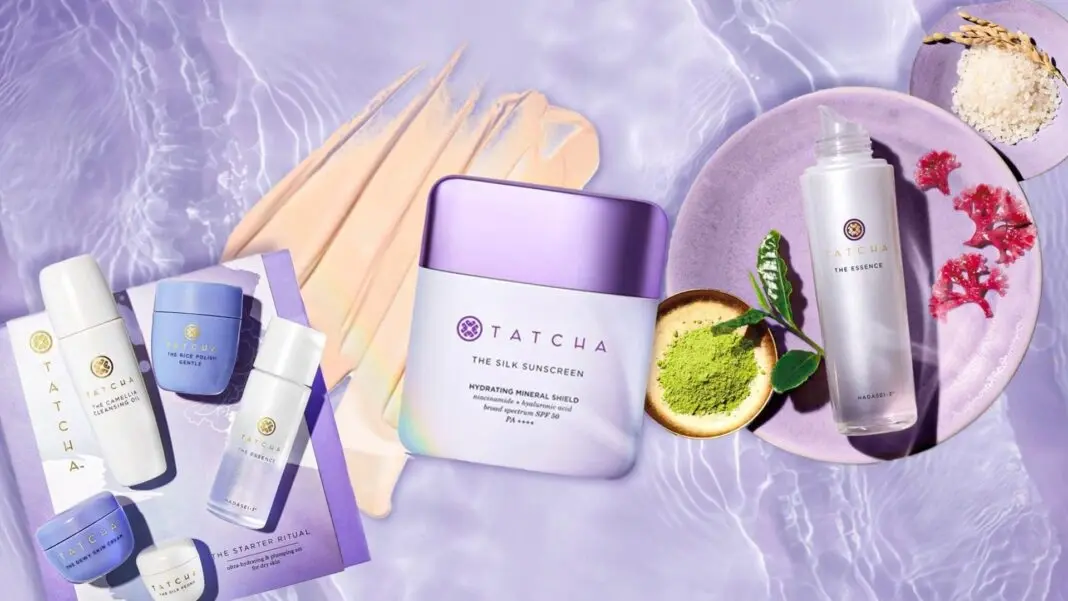
Aesop: Minimalist Sustainability with Apothecary Influence
Aesop’ s packaging is a masterclass in minimalist design and circular innovation, blending apothecary-inspired functionality with rigorous sustainability standards. Each element—from material selection to refill systems—reflects the brand’ s commitment to reducing environmental impact while maintaining its iconic aesthetic. Below is an in-depth exploration of its packaging philosophy, materials, and industry influence.
Signature Apothecary Design: Functionality Meets Timelessness
Amber Glass Bottles
• UV Protection: Amber glass shields light-sensitive formulations (e.g., Parsley Seed Antioxidant Serum) from UV degradation, preserving efficacy and reducing the need for synthetic preservatives.
• Material Integrity: Glass is chemically inert, ensuring no interaction with formulations. Aesop uses 602 tonnes of glass annually, prioritizing 100% recyclable and reusable options.
• Aesthetic Consistency: Uniform bottle shapes and sizes create a cohesive, pharmacist-inspired shelf presence, reinforcing brand identity.
Aluminum Tubes
• Lightweight Durability: Used for creams like Resurrection Aromatique Hand Balm, aluminum offers portability and infinite recyclability. Aesop is transitioning to 100% post-consumer recycled (PCR) aluminum for key products.
• Precision Dispensing: Nozzles minimize waste and ensure hygienic application, critical for high-viscosity products.
Minimalist Labels
• Text-Driven Design: Black sans-serif typography on cream or white backgrounds lists ingredients, usage instructions, and benefits directly on bottles, eliminating secondary packaging.
• Soy-Based Inks: Printed with eco-friendly inks on FSC-certified paper, labels prioritize recyclability and compostability.
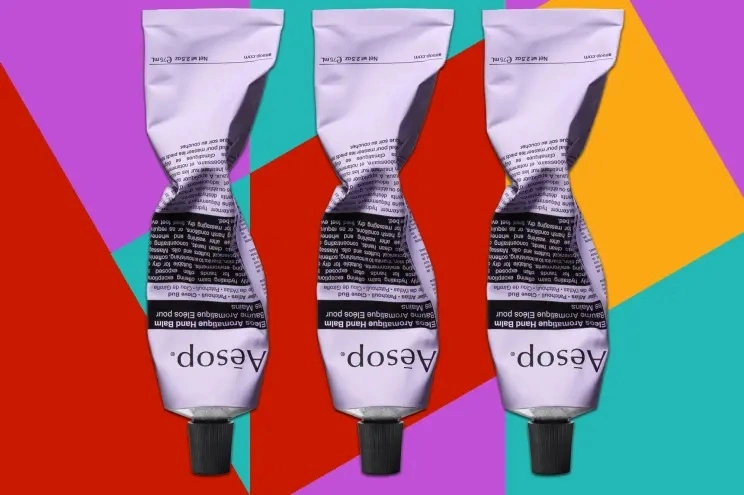
Material Innovation & Circular Systems
Recycled PET Plastic
• 97% PCR Content: Aesop’s 50mL, 100mL, and 500mL bottles use 97% post-consumer recycled PET, reducing reliance on virgin plastics and cutting greenhouse emissions by 30% compared to virgin PET.
• Challenges & Solutions: Trials with 50mL PCR PET bottles revealed issues like “panelling”(collapse due to pressure differences). Cross-functional teams optimized manufacturing to resolve this, ensuring stable production.
Refill Systems
• In-Store Pilots:
– Melbourne (2022): Customers purchase reusable glass bottles for cleansers and toners, refilling them via dispensers. One refill reduces plastic use by 80%.
– Adelaide Expansion (2025): Facial cleanser refills now available, with plans to scale to 50% of packaging by 2030.
Carbon-Neutral Manufacturing
• Supply Chain Standards: Suppliers must meet L’Oréal Groupe’ s sustainability criteria, including energy-efficient production and reduced water usage.
• APR Compliance: Packaging undergoes rigorous recyclability testing (e.g., Near Infrared Sorting, Extrusion Tests) to ensure compatibility with recycling systems.
Sustainability Roadmap: 2025 Targets
| Initiative | 2023 Progress | 2025 Goal |
| Recycled PET Plastic | 88% achieved | 100% PCR plastic |
| Refillable Packaging | 4 product lines | 50% portfolio |
| Reusable/Recyclable Materials | 83.8% achieved | 100% reusable/recyclable |
| PCR Aluminum Tubes | Pilots in select SKUs | Full transition |
• Collaborations: Partnered with RÆBURN for functional, reusable accessories merging utility and aesthetics.
• #WeAreAllies Coalition: Joined forces with REN Clean Skincare and others to standardize eco-packaging across the beauty industry.
Industry Impact & Cultural Shift
Redefining Luxury
• Minimalist Benchmark: Over 70% of competitors now use recyclable aluminum or glass, inspired by Aesop’s amber bottles.
• Apothecary Revival: The brand’s clinical aesthetic has normalized “humble” materials like rPET and PCR aluminum in luxury skincare, shifting focus from opulence to integrity.
Consumer Engagement
• Educational Outreach: Store consultants detail refill processes and material benefits, fostering eco-conscious habits.
• Unboxing Experience: Orders arrive in compostable paper bags with soy-inked inserts explaining ingredient origins (e.g., Uji green tea, Okinawa algae).
Future Innovations
• Bulk At-Home Refills: Testing doorstep refill services via partnerships like LOOP to complement in-store systems.
• Bio-Based Materials: Exploring mushroom-derived packaging and seaweed-based plastics to replace traditional materials.
• B Corp Certification: Aligning operations with B Corp standards to balance profit and planetary health.
Aesop’ s packaging transcends mere functionality—it embodies a philosophy where simplicity, sustainability, and sensory elegance coexist. By merging apothecary heritage with circular innovation, the brand continues to redefine luxury skincare, proving that environmental responsibility and aesthetic desirability are not mutually exclusive.
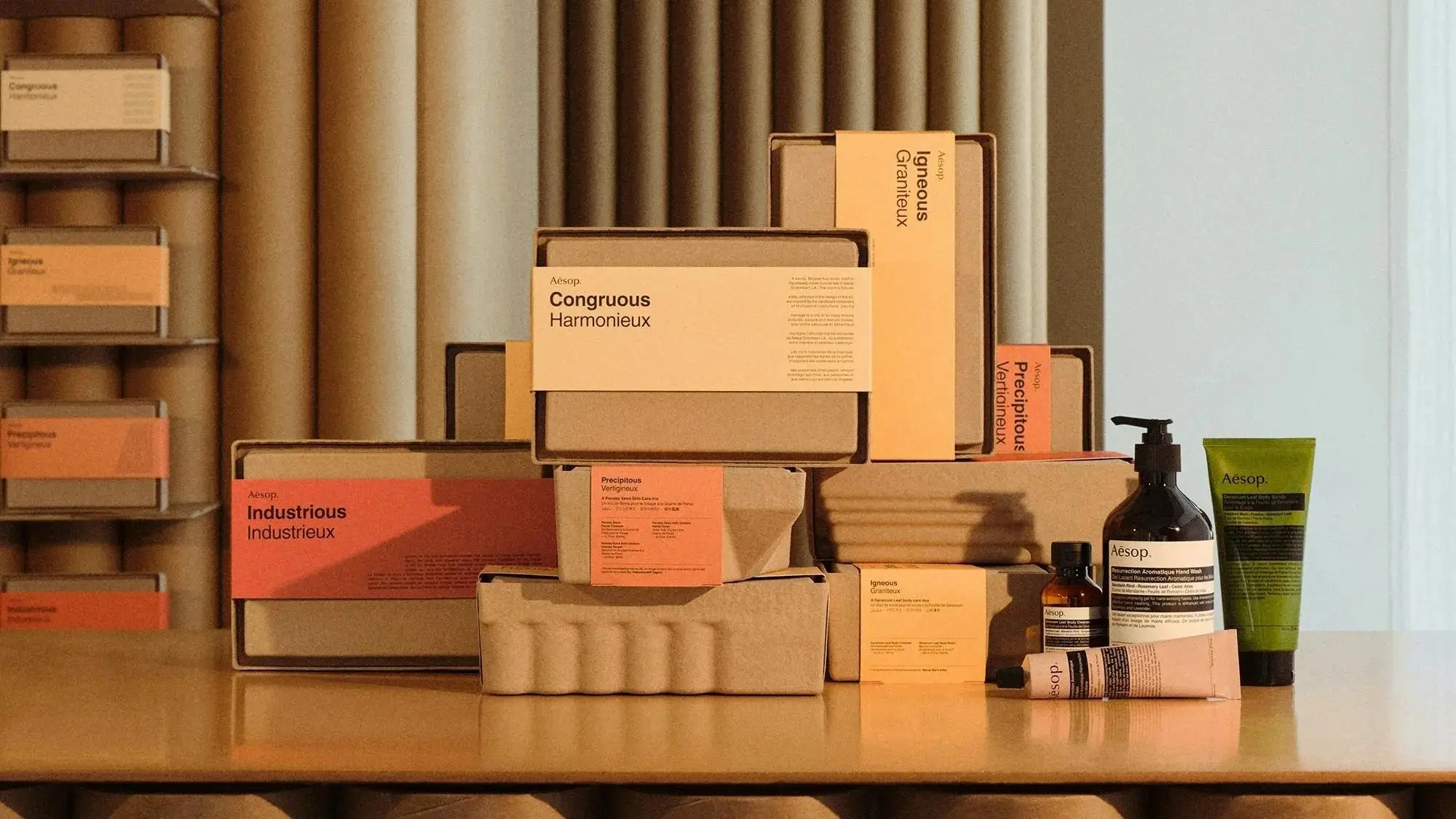
REN’ s Zero-Waste Commitment
REN Clean Skincare has emerged as a trailblazer in sustainable beauty, achieving its Zero Waste Pledge by 2021 and setting new industry benchmarks for circular packaging. Below is a detailed exploration of its initiatives, innovations, and ongoing commitments.
Zero Waste Milestones
2021 Achievement:
• 100% Recyclable/Reusable Packaging: By 2021, REN ensured all packaging is either recycled, recyclable, or reusable, eliminating single-use sachets (saving 4.4 million from landfills) and pioneering the world’s first 100% aluminum sample tube (saving 900 kg of plastic annually).
• Material Impact: Recycled 45 tons of plastic via Infinity Recycling technology and diverted 16 tons from landfills through global recycling guidelines.
Key Initiatives:
• LOOP Partnership: Became the first beauty brand to join LOOP’s doorstep refill system, enabling reusable packaging for products like Evercalm Rescue Mask.
• #WeAreAllies Coalition: Partnered with Biossance, Caudalie, Herbivore, and YOUTH TO THE PEOPLE to standardize recyclable, reusable, or recycled packaging by 2025 across all member brands.
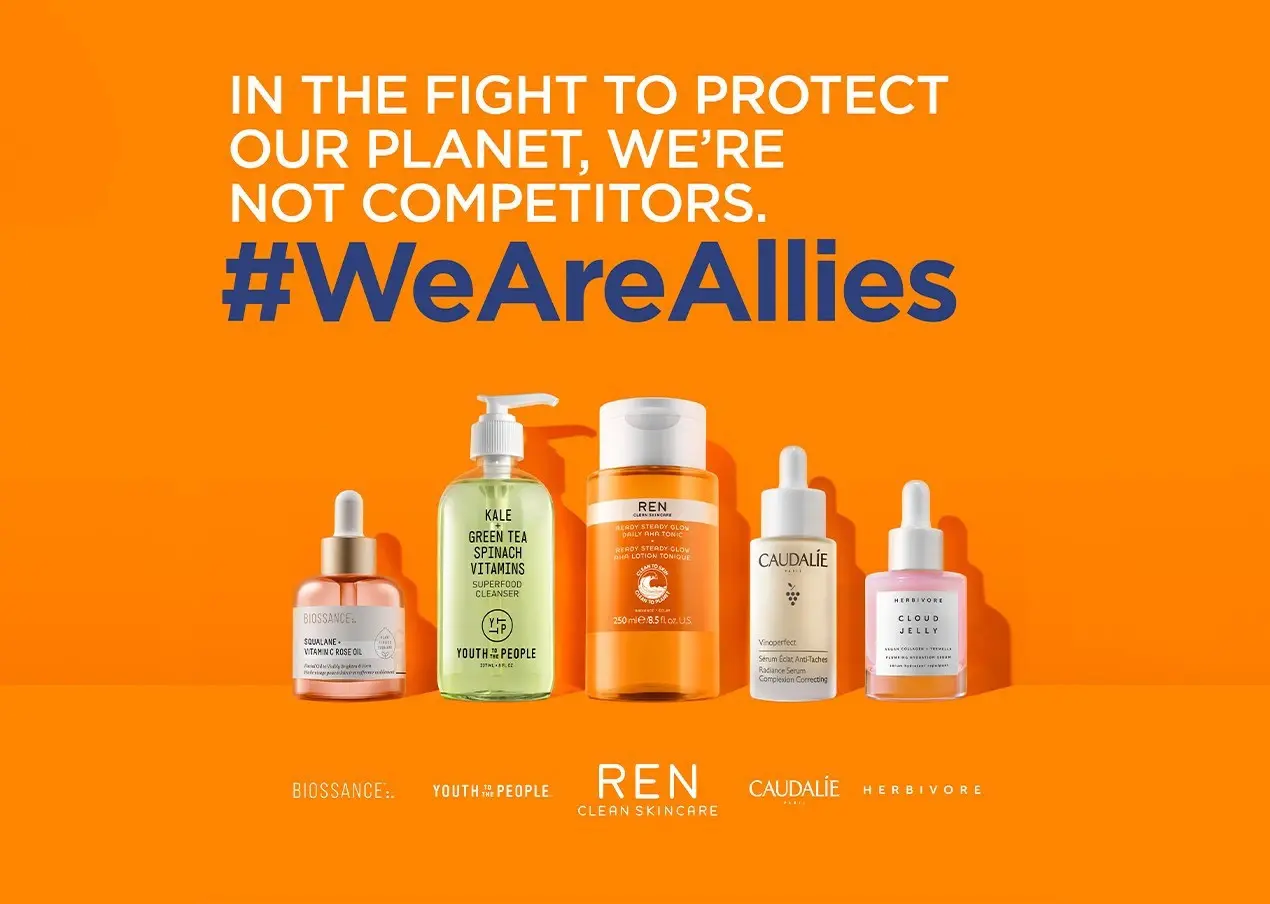
Material Innovations
Sustainable Packaging Designs
• Aluminum Tubes & PCR Glass: Transitioned to 100% recyclable aluminum tubes and partnered with Verescence for jars made with 20% post-consumer recycled (PCR) glass, reducing CO2 emissions by 5% during production.
• Mono-Material Pumps: Simplified packaging components to mono-materials (e.g., polypropylene) for easier recycling.
• Ocean Plastic: Launched products like Atlantic Kelp & Magnesium Body Cream in bottles made from reclaimed ocean plastic.
Refill Systems
• Boox Reusable Boxes: Introduced reusable shipping boxes for direct-to-consumer orders, reducing e-commerce waste.
• TerraCycle Collaboration: Enabled consumers to recycle empties globally via free drop-off programs.
Transparency & Ethical Sourcing
• Ingredient Integrity: Uses upcycled ingredients like pomegranate seed oil (from food industry waste) and lab-grown algae to protect ecosystems.
• Vegan & Cruelty-Free: Formulates without animal-derived ingredients and avoids animal testing, though its parent company (Unilever) conducts tests where legally required.
• Environmental Reporting: Publishes detailed sustainability metrics, including carbon reduction targets and material circularity progress.
Challenges & Criticisms
• Parent Company Impact: Owned by Unilever, which faces criticism for animal testing in China and political donations, impacting REN’s ethical ratings.
• Scalability Limits: High costs of PCR materials and refill infrastructure gaps remain hurdles, addressed through partnerships (e.g., LOOP) and tech investments.
Future Goals (2025 & Beyond)
| Initiative | Action |
| 100% Circular Packaging | Expand PCR aluminum, glass, and compostable materials. |
| Refill Expansion | Scale LOOP partnerships and in-store refill stations. |
| Carbon Neutrality | Reduce CO2 emissions by 40% by 2034 (via Verescence collaboration). |
| Ingredient Sustainability | Increase use of bio-fermented actives (e.g., hyaluronic acid from wheat). |
Industry Leadership
• Education & Advocacy: Shares packaging innovations (e.g., aluminum sample tubes) with competitors to accelerate sector-wide change.
• Awards & Recognition: Honored with WWD’s Sustainability Initiative of the Year (2021) for #WeAreAllies and zero-waste leadership.
By merging scientific rigor with environmental stewardship, REN Clean Skincare proves that high-performance skincare need not compromise planetary health. Its Zero Waste journey—marked by material innovation, cross-industry collaboration, and consumer empowerment—sets a blueprint for the beauty industry’s sustainable future.
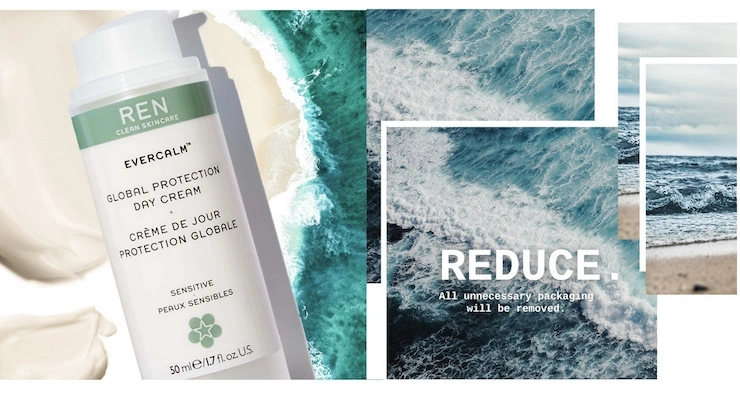
Othilapak’ s Sustainable Packaging Philosophy
At Othilapak, we’ ve positioned ourselves as pioneers in eco-conscious cosmetic packaging by focusing on materials and designs that align with circular economy principles. Over 80% of our product inventory features glass containers, chosen for their infinite recyclability and their role in reducing reliance on virgin plastics. We specialize in customizable, refillable solutions—like glass jars with PCR plastic lids and airless pumps—that help brands minimize waste while maintaining luxurious aesthetics. We also innovate with alternative materials, such as biodegradable PLA derived from cornstarch, bamboo fiber composites, and ocean-reclaimed plastics, offering our clients hybrid options that balance durability and environmental impact. Partnering with over 10,000 global brands, we design leak-proof, reusable systems tailored for products like serums, creams, and balms, ensuring both functionality and sustainability.
Beyond just materials, we embed sustainability deeply into our manufacturing ethos. We adhere to stringent certifications like ISO9000, BSCI, and REACH, ensuring ethical labor practices and chemical safety. By merging innovation with accountability, we not only meet the demand for sustainable packaging but also drive the beauty industry toward a waste-free future.
Conclusion: A Unified Vision for Sustainable Luxury
Tatcha, Aesop, and REN Clean Skincare exemplify how skincare brands can innovate in packaging while upholding luxury, functionality, and sustainability. Their approaches—from Tatcha’ s mottainai -inspired refillable jars and Aesop’ s minimalist apothecary designs to REN Clean Skincare’ s zero-waste aluminum tubes—demonstrate that environmental stewardship enhances, rather than compromises, premium experiences.
Achieving sustainable beauty packaging is a collective effort. Brands set benchmarks through cultural storytelling and material innovation, while suppliers like Othilapak provide the critical infrastructure—such as infinitely recyclable glass jars, PCR plastics, and refillable systems—to scale these solutions. Together, they prove that luxury and environmental responsibility thrive when every link in the supply chain commits to circularity.
As the beauty industry evolves, these pioneers redefine norms, proving packaging can be both opulent and eco-conscious. Through intentional design, recyclability, and waste reduction, they are reshaping the future of beauty packaging—one thoughtful jar, tube, and partnership at a time.
